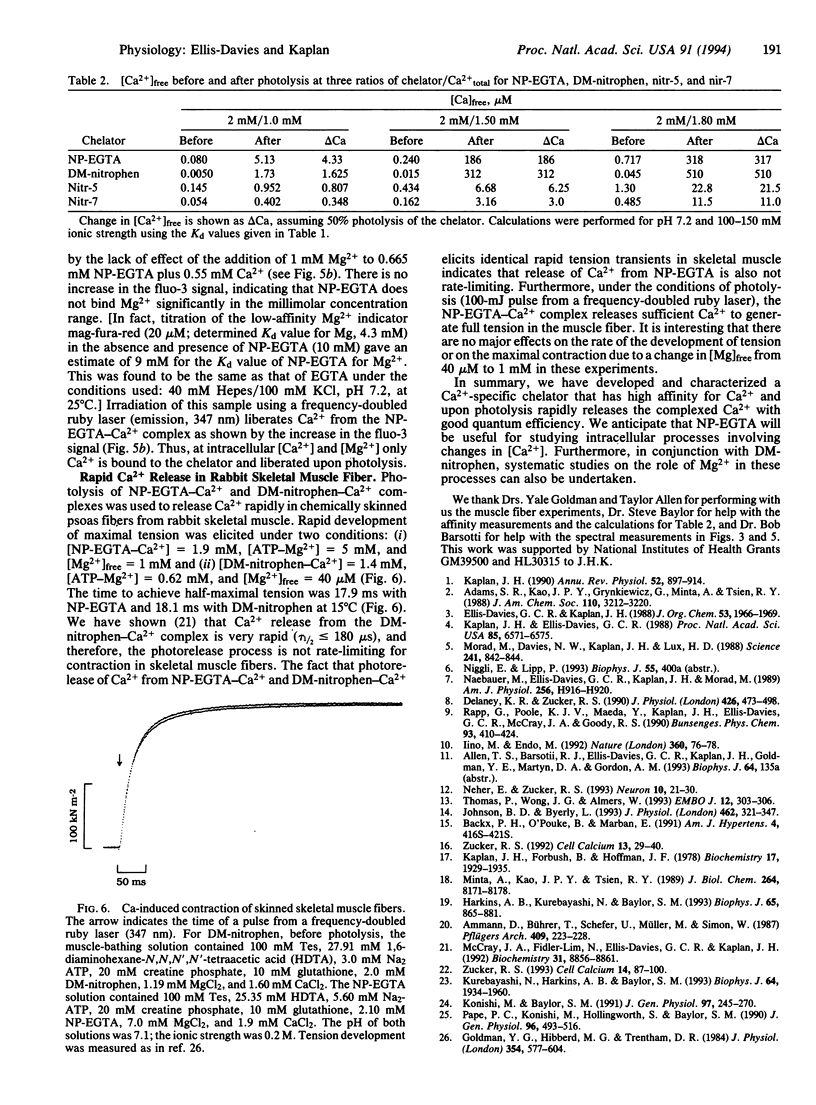Abstract
The synthesis and properties of a caged calcium are described. The compound is an ortho-nitrophenyl derivative of EGTA. It is synthesized in 10 steps and with 24% overall yield. The photosensitive chelator, nitrophenyl-EGTA, has a Kd value for Ca2+ of 80 nM and for Mg2+ of 9 mM. Upon exposure to UV radiation (approximately 350 nm), the chelator is cleaved, yielding iminodiacetic acid photoproducts with low Ca affinity (Kd = 1 mM). The quantum yield of photolysis of nitrophenyl-EGTA in the presence of Ca2+ is 0.23 and in the absence of Ca2+ is 0.20. In experiments with chemically skinned skeletal muscle fibers, a fully relaxed fiber equilibrated with nitrophenyl-EGTA-Ca2+ complex, in the presence of 1 mM free Mg2+, maximally contracted after a single flash from a frequency-doubled ruby laser (347 nm). Half-maximal tension was achieved in 18 ms at 15 degrees C. Nitrophenyl-EGTA provides a tool for the investigation of the mechanism of Ca(2+)-dependent physiological processes, since under conditions of normal intracellular Ca2+ and Mg2+ concentrations, only Ca2+ is bound by the photolabile chelator and on illumination released rapidly and in high photochemical yield.
Full text
PDF




Selected References
These references are in PubMed. This may not be the complete list of references from this article.
- Ammann D., Bührer T., Schefer U., Müller M., Simon W. Intracellular neutral carrier-based Ca2+ microelectrode with subnanomolar detection limit. Pflugers Arch. 1987 Jul;409(3):223–228. doi: 10.1007/BF00583469. [DOI] [PubMed] [Google Scholar]
- Backx P. H., O'Rourke B., Marban E. Flash photolysis of magnesium-DM-nitrophen in heart cells. A novel approach to probe magnesium- and ATP-dependent regulation of calcium channels. Am J Hypertens. 1991 Jul;4(7 Pt 2):416S–421S. doi: 10.1093/ajh/4.7.416s. [DOI] [PubMed] [Google Scholar]
- Delaney K. R., Zucker R. S. Calcium released by photolysis of DM-nitrophen stimulates transmitter release at squid giant synapse. J Physiol. 1990 Jul;426:473–498. doi: 10.1113/jphysiol.1990.sp018150. [DOI] [PMC free article] [PubMed] [Google Scholar]
- Goldman Y. E., Hibberd M. G., Trentham D. R. Relaxation of rabbit psoas muscle fibres from rigor by photochemical generation of adenosine-5'-triphosphate. J Physiol. 1984 Sep;354:577–604. doi: 10.1113/jphysiol.1984.sp015394. [DOI] [PMC free article] [PubMed] [Google Scholar]
- Harkins A. B., Kurebayashi N., Baylor S. M. Resting myoplasmic free calcium in frog skeletal muscle fibers estimated with fluo-3. Biophys J. 1993 Aug;65(2):865–881. doi: 10.1016/S0006-3495(93)81112-3. [DOI] [PMC free article] [PubMed] [Google Scholar]
- Iino M., Endo M. Calcium-dependent immediate feedback control of inositol 1,4,5-triphosphate-induced Ca2+ release. Nature. 1992 Nov 5;360(6399):76–78. doi: 10.1038/360076a0. [DOI] [PubMed] [Google Scholar]
- Johnson B. D., Byerly L. Photo-released intracellular Ca2+ rapidly blocks Ba2+ current in Lymnaea neurons. J Physiol. 1993 Mar;462:321–347. doi: 10.1113/jphysiol.1993.sp019558. [DOI] [PMC free article] [PubMed] [Google Scholar]
- Kaplan J. H., Ellis-Davies G. C. Photolabile chelators for the rapid photorelease of divalent cations. Proc Natl Acad Sci U S A. 1988 Sep;85(17):6571–6575. doi: 10.1073/pnas.85.17.6571. [DOI] [PMC free article] [PubMed] [Google Scholar]
- Kaplan J. H., Forbush B., 3rd, Hoffman J. F. Rapid photolytic release of adenosine 5'-triphosphate from a protected analogue: utilization by the Na:K pump of human red blood cell ghosts. Biochemistry. 1978 May 16;17(10):1929–1935. doi: 10.1021/bi00603a020. [DOI] [PubMed] [Google Scholar]
- Kaplan J. H. Photochemical manipulation of divalent cation levels. Annu Rev Physiol. 1990;52:897–914. doi: 10.1146/annurev.ph.52.030190.004225. [DOI] [PubMed] [Google Scholar]
- Konishi M., Baylor S. M. Myoplasmic calcium transients monitored with purpurate indicator dyes injected into intact frog skeletal muscle fibers. J Gen Physiol. 1991 Feb;97(2):245–270. doi: 10.1085/jgp.97.2.245. [DOI] [PMC free article] [PubMed] [Google Scholar]
- Kurebayashi N., Harkins A. B., Baylor S. M. Use of fura red as an intracellular calcium indicator in frog skeletal muscle fibers. Biophys J. 1993 Jun;64(6):1934–1960. doi: 10.1016/S0006-3495(93)81564-9. [DOI] [PMC free article] [PubMed] [Google Scholar]
- McCray J. A., Fidler-Lim N., Ellis-Davies G. C., Kaplan J. H. Rate of release of Ca2+ following laser photolysis of the DM-nitrophen-Ca2+ complex. Biochemistry. 1992 Sep 22;31(37):8856–8861. doi: 10.1021/bi00152a023. [DOI] [PubMed] [Google Scholar]
- Minta A., Kao J. P., Tsien R. Y. Fluorescent indicators for cytosolic calcium based on rhodamine and fluorescein chromophores. J Biol Chem. 1989 May 15;264(14):8171–8178. [PubMed] [Google Scholar]
- Morad M., Davies N. W., Kaplan J. H., Lux H. D. Inactivation and block of calcium channels by photo-released Ca2+ in dorsal root ganglion neurons. Science. 1988 Aug 12;241(4867):842–844. doi: 10.1126/science.2457253. [DOI] [PubMed] [Google Scholar]
- Neher E., Zucker R. S. Multiple calcium-dependent processes related to secretion in bovine chromaffin cells. Neuron. 1993 Jan;10(1):21–30. doi: 10.1016/0896-6273(93)90238-m. [DOI] [PubMed] [Google Scholar]
- Näbauer M., Ellis-Davies G. C., Kaplan J. H., Morad M. Modulation of Ca2+ channel selectivity and cardiac contraction by photorelease of Ca2+. Am J Physiol. 1989 Mar;256(3 Pt 2):H916–H920. doi: 10.1152/ajpheart.1989.256.3.H916. [DOI] [PubMed] [Google Scholar]
- Pape P. C., Konishi M., Hollingworth S., Baylor S. M. Perturbation of sarcoplasmic reticulum calcium release and phenol red absorbance transients by large concentrations of fura-2 injected into frog skeletal muscle fibers. J Gen Physiol. 1990 Sep;96(3):493–516. doi: 10.1085/jgp.96.3.493. [DOI] [PMC free article] [PubMed] [Google Scholar]
- Thomas P., Wong J. G., Almers W. Millisecond studies of secretion in single rat pituitary cells stimulated by flash photolysis of caged Ca2+. EMBO J. 1993 Jan;12(1):303–306. doi: 10.1002/j.1460-2075.1993.tb05657.x. [DOI] [PMC free article] [PubMed] [Google Scholar]
- Zucker R. S. Effects of photolabile calcium chelators on fluorescent calcium indicators. Cell Calcium. 1992 Jan;13(1):29–40. doi: 10.1016/0143-4160(92)90027-p. [DOI] [PubMed] [Google Scholar]
- Zucker R. S. The calcium concentration clamp: spikes and reversible pulses using the photolabile chelator DM-nitrophen. Cell Calcium. 1993 Feb;14(2):87–100. doi: 10.1016/0143-4160(93)90079-l. [DOI] [PubMed] [Google Scholar]


